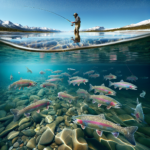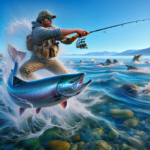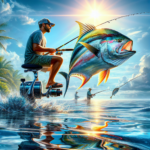Shark Fishing in California’s Coastal Waters

Introduction
Did you know that California’s coastal waters are home to over 30 species of sharks? This fascinating fact underscores the rich biodiversity of the region and sets the stage for an exciting exploration of shark fishing in California. In this article, we will delve into the techniques, species, locations, and seasonal considerations that make shark fishing in California a unique and rewarding experience. Whether you’re a seasoned angler or a curious beginner, this guide will provide you with the knowledge and tools you need to make the most of your shark fishing adventures.
Shark fishing in California matters not only for the thrill and challenge it offers but also for its cultural and ecological significance. Understanding the best fishing spots, mastering effective techniques, and adhering to regulations are crucial for a successful and sustainable fishing experience. Let’s dive in!
Background/Context
Historical or Cultural Significance
Shark fishing has a long history in California, dating back to the indigenous peoples who relied on the ocean for sustenance. Over the years, it has evolved into a popular recreational activity, attracting anglers from around the world. The cultural significance of shark fishing is evident in the numerous fishing communities along the coast, each with its own traditions and stories.
Geographical Overview
California’s coastline stretches over 800 miles, offering a diverse range of fishing environments. From the rocky shores of Northern California to the sandy beaches of Southern California, the state’s coastal waters are teeming with marine life. The climate varies from the cool, foggy conditions of the north to the warm, sunny weather of the south, creating different habitats that support a variety of shark species.
Key Points/Details
Fishing Techniques
Technique Overview
Shark fishing techniques can vary widely, but some of the most common methods include surf fishing, boat fishing, and kayak fishing. Each technique has its own set of challenges and rewards, making it important to choose the right one based on your experience level and the specific conditions of your fishing location.
When and Where to Use
Surf fishing is ideal for those who prefer to stay on land, and it can be particularly effective in areas with strong currents and abundant baitfish. Boat fishing allows anglers to reach deeper waters where larger sharks are often found. Kayak fishing offers a more intimate experience, allowing you to navigate closer to shorelines and reefs where smaller sharks may be hiding.
Recommended Gear
- Rods: Heavy-duty rods with a strong backbone are essential for handling the power of a shark.
- Reels: High-capacity spinning or conventional reels with a strong drag system.
- Lines: Braided lines with a test strength of at least 50-80 pounds.
- Bait: Fresh or frozen bait such as mackerel, squid, or bonito.
- Hooks: Circle hooks are recommended for their effectiveness and reduced harm to sharks.
Species Information
Species Overview
California’s coastal waters are home to a variety of shark species, including the Leopard Shark, Thresher Shark, and Blue Shark. Each species has its own unique habits and preferred habitats, making it important to understand their behavior for successful fishing.
Best Practices
To catch Leopard Sharks, focus on shallow bays and estuaries during the warmer months. Thresher Sharks are often found in deeper waters and are known for their acrobatic leaps when hooked. Blue Sharks prefer cooler, open waters and are most commonly caught during the summer and fall.
Location Information
Top Fishing Spots
- San Francisco Bay: Known for its abundant Leopard Shark population.
- Monterey Bay: Offers opportunities to catch Thresher Sharks and Blue Sharks.
- San Diego: A popular spot for kayak fishing and surf fishing, with a variety of shark species.
Regulations and Licenses
California has strict regulations to ensure sustainable shark fishing. Anglers must have a valid fishing license, and there are specific size and bag limits for different shark species. It’s important to check the latest regulations from the California Department of Fish and Wildlife before heading out.
Seasonal Considerations
Seasonal Variations
Shark fishing conditions can change dramatically throughout the year. In the spring and summer, warmer waters attract a variety of shark species closer to shore. Fall and winter can be more challenging, with cooler temperatures and rougher seas.
Best Times to Fish
The best times to fish for sharks in California are typically during the early morning and late evening when sharks are most active. Summer and early fall are generally the most productive seasons.
Events and Tournaments
Event Overview
California hosts several shark fishing tournaments throughout the year, such as the annual Sharkfest in San Diego. These events offer a chance to compete with other anglers and showcase your skills.
Preparation Tips
To prepare for a tournament, make sure your gear is in top condition, practice your casting and reeling techniques, and familiarize yourself with the tournament rules and regulations.
Tips and Best Practices
General Tips
- Always use fresh bait for the best results.
- Pay attention to tides and currents, as sharks are more active during certain tidal movements.
- Practice catch and release to help conserve shark populations.
Avoid Common Mistakes
- Using the wrong gear: Make sure your equipment is suitable for shark fishing.
- Ignoring regulations: Always stay updated on local fishing laws and regulations.
- Not being patient: Shark fishing can require long hours of waiting, so be prepared for a test of patience.
Advanced Techniques
- Chumming: Use a mixture of fish parts and blood to attract sharks to your location.
- Drift fishing: Allow your bait to drift with the current to cover more area and increase your chances of a bite.
- Using live bait: Live bait can be more enticing to sharks and increase your chances of a successful catch.
Gear and Equipment Recommendations
Essential Gear
- Heavy-duty rod and reel
- Braided fishing line (50-80 lb test)
- Circle hooks
- Fresh or frozen bait
- Chum bucket
Optional Gear/Upgrades
- Kayak or small boat for better access to fishing spots
- Fish finder to locate sharks more easily
- High-quality tackle box to organize your gear
Where to Buy or Rent
Local tackle shops in coastal cities like San Diego, Monterey, and San Francisco offer a wide range of fishing gear. Online stores such as Bass Pro Shops and Cabela’s also provide extensive selections and convenient shipping options.
Safety and Conservation
Safety Tips
- Always wear a life jacket when fishing from a boat or kayak.
- Be aware of weather conditions and avoid fishing during storms or rough seas.
- Handle sharks with care to avoid injury to yourself and the fish.
Conservation Practices
- Practice catch and release to help maintain shark populations.
- Use circle hooks to reduce harm to sharks.
- Follow all local regulations and size limits.
Planning Your Trip
Accommodations
There are numerous accommodations near popular fishing spots, ranging from budget-friendly motels to luxury resorts. In San Diego, consider staying at the Bahia Resort Hotel for its proximity to the water. In Monterey, the Monterey Plaza Hotel & Spa offers stunning ocean views.
Travel Tips
California’s coastal cities are well-connected by major highways and airports. Renting a car is recommended for easy access to various fishing spots. Be sure to check traffic conditions, especially during peak tourist seasons.
Additional Activities
When you’re not fishing, explore other attractions such as the Monterey Bay Aquarium, the San Diego Zoo, or the Golden Gate Bridge in San Francisco. These activities make the trip enjoyable for the whole family.
Frequently Asked Questions (FAQs)
Do I need a special license to fish for sharks in California?
No, a standard California fishing license is sufficient, but you must adhere to specific regulations for shark fishing.
What is the best time of year to fish for sharks in California?
The best time is typically during the summer and early fall when water temperatures are warmer.
Can I keep the sharks I catch?
Some species have size and bag limits, while others are protected. Always check the latest regulations before keeping any sharks.
Is shark fishing safe?
Yes, but it’s important to follow safety guidelines, use appropriate gear, and handle sharks carefully to avoid injury.
Conclusion
Shark fishing in California’s coastal waters offers an exciting and rewarding experience for anglers of all levels. By understanding the techniques, species, locations, and regulations, you can enhance your fishing adventures while contributing to the conservation of these magnificent creatures. So grab your gear, head to the coast, and embark on an unforgettable shark fishing journey!
Whether you’re looking to try a new technique, visit a top fishing spot, or prepare for a tournament, this guide has provided you with the essential information you need. Happy fishing!




